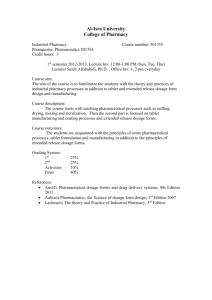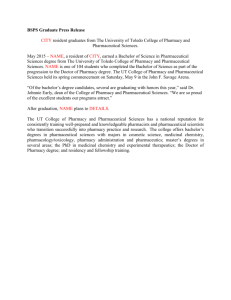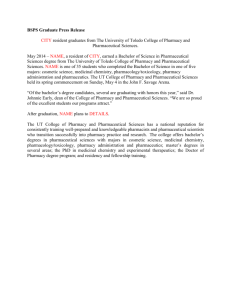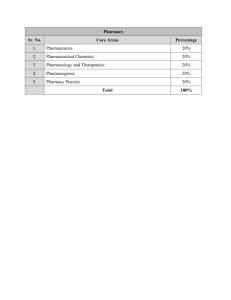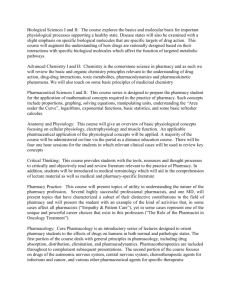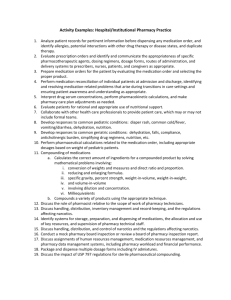UIC Professional Competencies and Outcome Expectations
advertisement
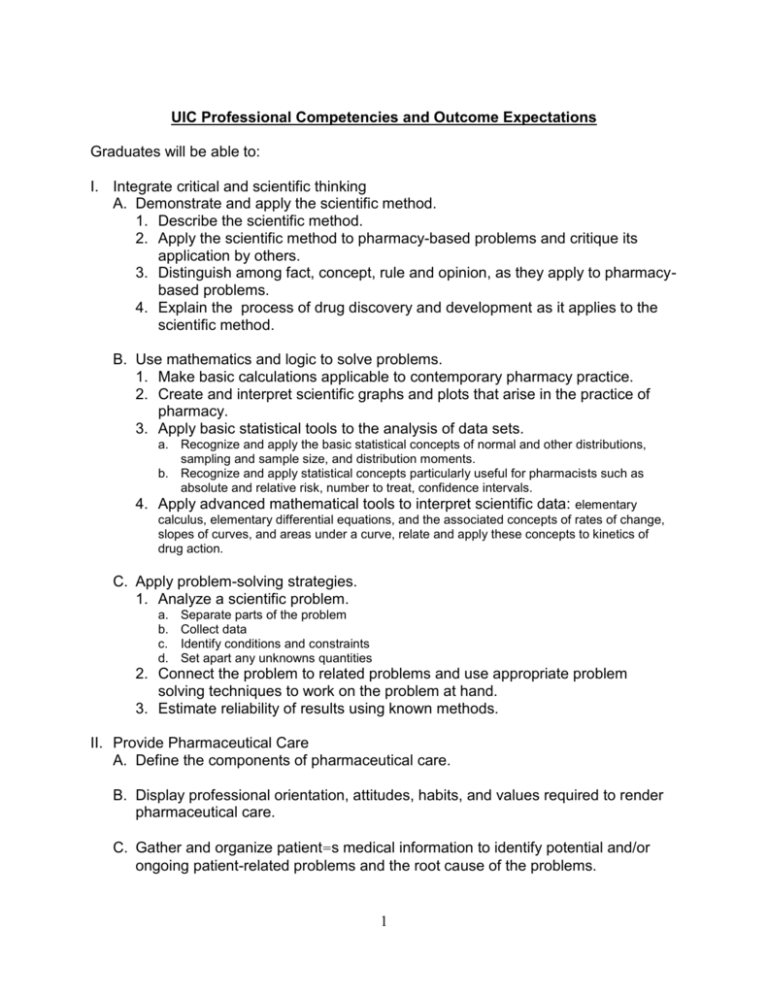
UIC Professional Competencies and Outcome Expectations Graduates will be able to: I. Integrate critical and scientific thinking A. Demonstrate and apply the scientific method. 1. Describe the scientific method. 2. Apply the scientific method to pharmacy-based problems and critique its application by others. 3. Distinguish among fact, concept, rule and opinion, as they apply to pharmacybased problems. 4. Explain the process of drug discovery and development as it applies to the scientific method. B. Use mathematics and logic to solve problems. 1. Make basic calculations applicable to contemporary pharmacy practice. 2. Create and interpret scientific graphs and plots that arise in the practice of pharmacy. 3. Apply basic statistical tools to the analysis of data sets. 4. a. Recognize and apply the basic statistical concepts of normal and other distributions, sampling and sample size, and distribution moments. b. Recognize and apply statistical concepts particularly useful for pharmacists such as absolute and relative risk, number to treat, confidence intervals. Apply advanced mathematical tools to interpret scientific data: elementary calculus, elementary differential equations, and the associated concepts of rates of change, slopes of curves, and areas under a curve, relate and apply these concepts to kinetics of drug action. C. Apply problem-solving strategies. 1. Analyze a scientific problem. a. b. c. d. Separate parts of the problem Collect data Identify conditions and constraints Set apart any unknowns quantities 2. Connect the problem to related problems and use appropriate problem solving techniques to work on the problem at hand. 3. Estimate reliability of results using known methods. II. Provide Pharmaceutical Care A. Define the components of pharmaceutical care. B. Display professional orientation, attitudes, habits, and values required to render pharmaceutical care. C. Gather and organize patient=s medical information to identify potential and/or ongoing patient-related problems and the root cause of the problems. 1 D. Collaborate with physicians, other health care professionals, patients, and/or their caregivers to formulate a pharmaceutical care plan. 1. Identify and communicate pertinent information from the patient's medical record to appropriate health care professionals. 2. Refer the patient to other health care agencies or professionals when appropriate, document the intervention and establish a follow-up procedure. 3. Integrate information as needed to design, implement, and evaluate patientspecific pharmacotherapeutic regimens to prevent or resolve medicationrelated problems and to respond to information requests. 4. Recommend appropriate drug therapy (e.g., prescription, nonprescription, herbal). a. Use knowledge of the basic pharmaceutical sciences (i.e., medicinal chemistry, pharmaceutics, pharmacodynamics, pharmacogenomics, pharmacokinetics, physiology) to select appropriate medications based on patient’s medical needs. b. Determine the appropriateness of a prescription=s dose, dosage form, route of administration and frequency of administration. c. Determine the appropriateness of a nonprescription product or dietary supplements, dosage, dosage form, route of administration and frequency of administration. 5. Determine the appropriate drug delivery system for the patient based on his/her individual needs, characteristics, and cultural orientation. 6. Evaluate and recommend medication doses and dosage schedules based on the evaluation of relevant patient factors, including age, lab values, physiologic, pharmacodynamic, pharmacokinetic and pharmacogenomic parameters and concomitant drug therapy. 7. Assess the appropriateness and safety of a product=s original packaging for use by a particular patient. E. Implement the pharmaceutical care plan to meet patient needs. 1. Clarify, add, and/or correct prescription order information when necessary. 2. Accurately prepare and dispense prescriptions. 3. Accurately compound individual or bulk medications including sterile dosage forms (e.g., IV mixtures) as well as nonsterile products. a. Apply scientific knowledge to evaluate extemporaneous and commercial preparations for appropriateness, stability and method of preparation. b. Collect and analyze data on the quality and stability of compounded pharmacy products. c. Identify the physical-chemical properties related to the design of dosage forms. d. Evaluate possible physical-chemical incompatibilities among components of a given formulation and recommend appropriate alternatives. e. Identify the physical and chemical factors that contribute to drug incompatibilities when mixed with other preparations. f. Perform proper quality control procedures. g. Apply the knowledge of pharmaceutical technology to the preparation of dosage forms for conventional and novel drug delivery systems. h. Maintain professional proficiency according to the current compounding standards 4. Provide counseling to patients and/or their caregivers relative to proper therapeutic self-management. 5. Research, compile and evaluate the latest literature necessary for the selection of medical goods and devices. 2 6. Provide counseling relative to the proper use of specific medical goods and devices. F. Document pharmaceutical care activity in the patient=s medical record or profile to facilitate communication and collaboration among providers. 1. Develop and maintain a comprehensive database of information relative to each patient. 2. Record information related to the provision of pharmaceutical care to individual patients. G. Plan and perform ongoing patient evaluation to identify encountered additional drug-related and nondrug-related problems. 1. Assess and/or optimize patient therapeutic self-management and adherence. 2. Monitor the safety and efficacy of pharmaceutical care plans. H. Maintain professional proficiency by identifying and analyzing emerging issues, products and services that may impact patient-specific therapeutic outcomes. III. Establish and Manage Pharmacy Practice A. Become familiar with pharmacy operations 1. Describe the components of pharmacy operations. 2. Describe the nature of risk management in pharmacy practice environment. a. Describe risk reduction strategies commonly used in pharmacy care delivery. b. Recognize risk in pharmacy operations, types of issues under risk management and strategies to prevent them. B. Manage medication distribution and inventory control 1. Use drug product selection guidelines for multi-source products (e.g., generic substitutions). 2. Select high quality prescription and non-prescription drug products, herbal and dietary supplements, diagnostic products, medical goods and devices and drug delivery systems by using appropriate biopharmaceutic, pharmacoeconomic and quality control information. 3. Competently maintain records of products received and removed from inventory. 4. Describe good manufacturing process. 5. Distinguish drug distribution systems for various practice settings consistent with regulatory, pharmacoeconomic and professional standards. a. Use and evaluate policies and procedures for the compounding, preparing, dispensing and distributing of pharmaceuticals and supplies in a given drug distribution system. b. Perform drug control, storage, and security functions for a given drug distribution system. C. Manage human resources 1. Maintain supportive environment that contributes to fulfilling the mission for a specific practice setting. 2. Demonstrate effective communication skills necessary to work with supportive personnel, other pharmacists and managers. 3 D. Manage facilities and equipment 1. Apply relevant regulations and professional standards to maintain current facilities and equipment. 2. Define or specify information management system needs that meet legal, business, archival and patient care needs. E. Manage fiscal resources 1. Develop a business plan using sound principles of fiscal management. 2. Describe factors (e.g., economic, human) that influence the finances of pharmacy operations. F. Define the role of pharmacy practice within a changing health care system in various practice sites. 1. Identify the potential opportunities and barriers to change. 2. Identify strategies to overcome possible barriers to change. G. Develop innovative pharmacy practices which may provide reimbursable patientcentered care. 1. Describe strategies for the marketing and reimbursement of pharmaceutical care services to other health care professionals and to the public. 2. Describe the current mechanism for reimbursement of pharmaceutical care services in the U.S. health care system. 3. Describe evaluation methods to determine if a new pharmacy service meets its original goals and objectives. H. Continue professional proficiency by examining pending issues and services that may impact pharmacy reimbursement and the management of human, physical, medical, informational and technological resources. IV. Manage Medication Use Systems A. Participate in the process for reporting and managing medication errors and adverse drug reactions. B. Demonstrate the process for conducting a Drug Utilization Review/Medicine Utilization Evaluation (DUR/MUE) in a medication management system. 1. Develop appropriate criteria and outcome indicators for a DUR/MUE. 2. Develop and conduct a DUR/MUE C. Describe the processes involved in formulary management. 1. Explain the process of drug product inclusion in a formulary 2. Manage the formulary system at specific practice sites. D. Apply elements of continuous quality improvement in the delivery of pharmaceutical care. 1. Identify the elements of comprehensive quality assurance program(s). 4 2. Define and document quality assurance activities consistent with regulatory requirements and professional standards. 3. Define and evaluate measures of humanistic outcomes (e.g., health-related Quality of Life (QOL), patient satisfaction) in pharmaceutical care services. E. Maintain professional proficiency by identifying and analyzing emerging issues, products and services that may impact medication use systems. V. Promote Health, Wellness and Disease Prevention A. Earn and maintain a CPR and an American Red Cross First Aid certificate. B. Earn and maintain an immunization certification. C. Provide appropriate emergency care when indicated. 1. Provide emergency first aid treatment and cardiopulmonary resuscitation (CPR). 2. Provide appropriate poison resources and referrals to consumers or health care professionals. D. Promote public awareness of health, wellness and disease prevention. 1. Describe Public Health initiatives in the United States and the rationale for health promotion, wellness, and disease prevention (e.g., Healthy People 2010, Report of the US Preventative Task Force or the most current resources). 2. Participate in basic pubic health promotion, wellness and disease prevention initiatives. E. Maintain professional proficiencies that will affect the quality of disease prevention services and public health policies. VI. Provide Drug Information and Education A. Evaluate drug information literature and other pharmacy related literature. 1. Define and apply basic concepts of biostatistics including types of data, data distribution, descriptive and inferential statistics, and measures of variability. 2. Evaluate research designs within research studies. 3. Apply the evaluation skills and the result to decision-making. 4. Incorporate literature evaluation and results into an oral or written format in language appropriate for the target audience. B. Provide drug and health-related information to meet the specific needs of healthcare professionals and the general public. 1. Use effective communication skills to determine the nature and specific aspects of the drug information request. 2. Retrieve appropriate information to satisfy a drug information request. 3. Provide a timely, comprehensive response to requests using appropriate and content-specific vocabulary and format. 5 4. Use a systematic method to remain current with pertinent biomedical literature. C. Design, develop, present and evaluate informational and educational materials tailored to the needs and educational level of a given audience. 1. Assess the educational needs and background of the intended audience related to drugs, drug use, or health promotion. 2. Design and deliver educational programs about drugs, drug use, drug abuse and/or other health-related topics. 3. Use appropriate teaching methods to reach intended audience. 4. Evaluate the effectiveness of healthcare programs. D. Maintain professional proficiency that may affect the ongoing evaluation and analysis of drug literature. 6
